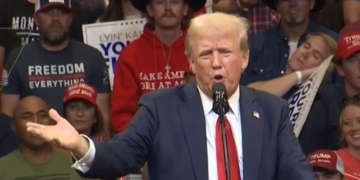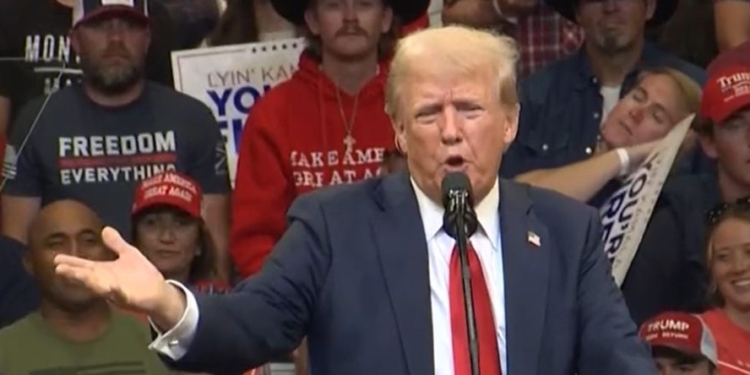Public polls missed badly in the 2016 and 2020 presidential elections, but pollsters are not convinced that 2024’s surveys will end up being accurate, according to several who spoke with the Daily Caller News Foundation.
In 2016 and 2020, public polls generally failed to sufficiently account for non-college educated white voters, a demographic that forms a key pillar of former President Donald Trump’s base. While most pollsters are making an effort to not undercount those hard-to-reach Trump supporters in 2024, properly forecasting the breakdown of the electorate that ultimately turns out to vote remains a difficult task given the limitations of polling techniques for surveying groups like young men and non-college educated Americans, multiple pollsters told the DCNF.
“The single biggest mistake was under-counting non-college voters. It used to be that when we undercounted non-college voters, we were sort of unintentionally putting a thumb on the scale for Republicans, because Republican voters used to be more college-educated, they tended to be wealthier, so an undercount of non-college voters meant that you were essentially over-sampling Republicans and under-sampling Democrats,” Jon McHenry, a GOP pollster, told the DCNF. “Now that’s sort of flipped, so that’s one part of it, is that a lot of the polls in 2016 and 2020 were undercounting non-college voters. The lower-quality media polls that are done online are still getting more college-educated voters than non-college-educated voters.”
University of Virginia Center for Politics Director Larry Sabato suggested that pollsters are not sure if they are accurately gauging Trump’s support during an appearance on CNN earlier in October.
Ultimately, reaching and properly weighing this slice of the electorate remains a major challenge for public polls — which are typically of lower quality than the private internal polls commissioned by campaigns — forecasting how things will shake out in 2024. Currently, the RealClearPolitics polling average, which combines many national polls into a single metric, shows Vice President Kamala Harris ahead by 0.6 percentage points nationally with Trump maintaining comparably thin leads in all of the seven swing states.
In the 2016 election, pollsters accurately predicted that former Secretary of State Hillary Clinton would win the national popular vote by a relatively wide margin, but they underestimated Trump’s support from lower-education and working-class white people in crucial states like Wisconsin and Pennsylvania, which most polls incorrectly predicted Clinton would win, according to a November 2016 assessment published by Pew Research Center. Then, in 2020, it was “clear that Trump’s strength was not fully accounted for in many, if not most, polls,” according to Pew, and that President Joe Biden’s expected electoral and popular vote victories turned out to be much narrower than widely projected, according to the American Association for Public Opinion Research’s evaluation of the 2020 cycle’s public polling.
“I don’t think that the campaigns are making those mistakes again,” McHenry told the DCNF, referencing misleading internal polling of campaigns past. “As you look at, say, the poll tracker at The New York Times, they’ve got firms in there that I’ve never heard of, and that doesn’t mean that they’re not good, but it means that we should be suspicious. Do they have a good track record? How are they conducting their polls? Is it just an easy online panel that’s convenient to them, versus a more robust attempt to make sure that people are accurately represented?”
Robert Cahaly, a senior strategist and pollster for the Trafalgar Group, says he thinks the “hidden” Trump vote that pollsters have struggled to capture in elections past remains a real phenomenon in 2024. Trafalgar was one of the most accurate polling outfits for the 2020 presidential race, though “they didn’t get a lot of credit for it because they happened to ‘call’ some of the close states wrong,” according to polling expert Nate Silver.
“I think what we’re seeing is a higher degree of hidden Trump vote in 2024 than we saw in 2016. The highest degree in 2024, second-highest in 2016 and the lowest hidden vote in 2020,” Cahaly told the DCNF. “For one, it’s hard to get Republicans to take surveys, and secondly, getting them to give you a real answer when they do take one is also tough, because many Republicans default to ‘undecided.’”
However, Democrats have robust voter mobilization infrastructure in place in must-win swing states, meaning that whatever “hidden” Trump vote may exist may be met by higher-than-anticipated turnout for Harris, according to Cahaly.
WATCH: Kamala gesticulates and uses weird voices while talking about democracy at a town hall yesterday. pic.twitter.com/anvbTnFCcY
— Daily Caller (@DailyCaller) October 22, 2024
Moreover, the methods of sampling for public polls — and even private polling for lower-stakes campaigns — are typically not as thorough or expensive as internal polling for a presidential race, according to John McLaughlin, a pollster for the Trump Campaign.
“Oftentimes, media polls and lower campaign polls, they can’t afford the expense of the higher quality poll. So, what they do is random calling, they do robocalls which skew to landlines and don’t have enough younger people on them, they don’t use live interviewers. They use random online databases, but we love to center people who take calls,” McLaughlin told the DCNF. “So the sampling is cheaper, but it’s prone to error, and there are more people voting early now. It gets harder and harder to get through to voters and ask them how they’re voting.”
“The only way to account for the previous bias in 2016 and 2020 is that they were letting the overall media bias affect their polling operations,” McLaughlin added. “The evidence that the polls are better now is that the Left is complaining that they’re too good for Trump.”
McLaughlin pointed to an October 2020 Washington Post-ABC News poll that showed Biden enjoying a 17-point lead over Trump in Wisconsin, a state that Biden only won by less than 1%, as a clear example of politicized polling.
Celinda Lake, an experienced Democratic pollster, has her own views about the challenges of public polling and the factors that may make it less reliable than the private internal polls campaigns use for strategic purposes.
“I think the hardest thing in the polling is to figure out the turnout,” Lake told the DCNF. “What’s the Trump surge going to be? Is there a Harris surge? What will it be?”
“It isn’t so much the quiet Trump voter, it’s the Trump voter who is not in our universe. So for example, if you’re looking at likely voters, if you look at the voters who registered in 2020 but did not vote, they lean Trump,” Lake continued. “Well, they would often not be in people’s turnout models. So it isn’t that people are quiet about their support, and like past years, Trump is encouraging his supporters to be vocal about their support. It’s more that surge voters are not in the universe because they don’t have voting history.”
Many pollsters are running different turnout models to inform their findings, meaning that they run polls with different underlying assumptions about what slices of the electorate will show up to vote and in what numbers to assess several different scenarios, Lake told the DCNF. Another problem with public polls is that the media often reads too far into them when they report on the latest figures, in Lake’s view.
All content created by the Daily Caller News Foundation, an independent and nonpartisan newswire service, is available without charge to any legitimate news publisher that can provide a large audience. All republished articles must include our logo, our reporter’s byline and their DCNF affiliation. For any questions about our guidelines or partnering with us, please contact [email protected].



























 Continue with Google
Continue with Google